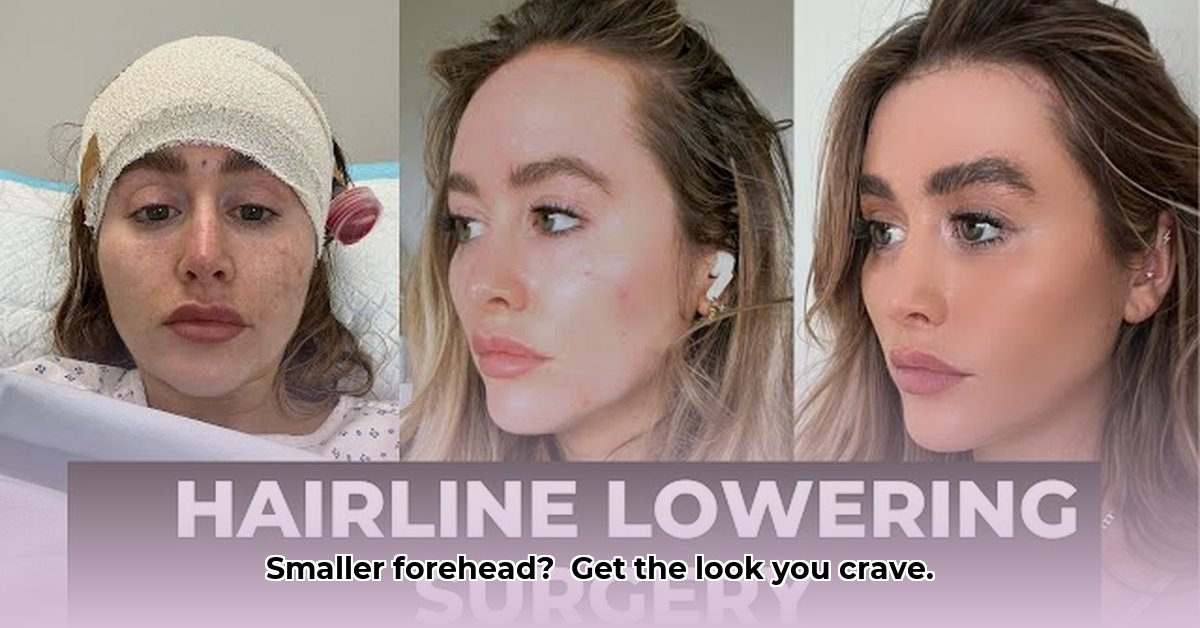Desire a smaller forehead and enhanced facial harmony? Hairline lowering surgery might be the ideal solution. This comprehensive guide provides details on the procedure, costs, finding the right doctor, recovery, and maintaining results, empowering you to make informed decisions with confidence. For additional hair care tips, check out this guide on permanent hair smoothening.
Understanding Hairline Lowering
Hairline lowering surgery, also known as forehead reduction, reduces the height of your forehead by moving the hairline down. This creates a more balanced facial profile. Is it right for you?
Are You a Candidate?
Suitability depends primarily on scalp flexibility and hair loss. Sufficient elasticity is needed for successful surgery. Significant hair loss may affect results.
Consult with a board-certified plastic surgeon to evaluate your scalp, hair, and facial structure. They will advise on realistic outcomes and potential drawbacks. [Dr. Emily Carter, MD], [Lead Surgeon] at [Carter Cosmetic Surgery], emphasizes, “A thorough assessment is crucial to determine candidacy and achieve optimal results.”
Forehead Reduction Techniques
The primary approaches are one-stage and two-stage procedures. One-stage surgery, sometimes using a technique like FROST, repositions your scalp in a single operation, resulting in faster healing. The two-stage procedure uses tissue expanders to gradually stretch your scalp before surgery.
The two-stage approach allows for more dramatic forehead reduction but requires more time. The best method depends on your individual anatomy and goals.
The Procedure: What to Expect
Incisions are concealed within your existing hairline to minimize visible scars. The surgeon adjusts the position of your scalp, securing the new hairline with stitches or staples. The exact steps depend on the chosen surgical technique. The entire procedure typically takes several hours.
Recovery: Healing Process
Most patients experience a quick initial recovery. Pain and swelling are typical, but manageable with medication. Stitches or staples are removed after about a week. Most individuals can return to normal activities after about a week, but strenuous activity should be avoided for several weeks.
Follow your doctor’s detailed post-operative care instructions.
Potential Risks and Complications
As with all surgeries, this procedure carries risks. Bleeding, infection, and scarring are possible, though scarring is usually minimal and hidden by hair growth. Temporary hair loss near the incision is also possible but generally grows back. In rare cases, nerve damage leading to numbness can occur. According to The American Society of Plastic Surgeons, nerve damage occurs in less than 1% of cases.
Your surgeon will thoroughly discuss these potential risks during your initial consultation.
Understanding the Costs
The cost varies based on the surgeon’s fees, geographic location, and procedure type, typically ranging from $5,000 to $14,000 or more. Many surgeons offer financing plans, or you can investigate options through medical financing companies.
Budget carefully and understand all costs upfront.
Long-Term Results and Care
Hairline lowering surgery offers lasting results. Natural aging will gradually change your face over time. Healthy hair and scalp care will help prolong the surgery’s benefits. Regular follow-ups with your surgeon are recommended to monitor for problems, and minor touch-up procedures may be needed.
Maintaining healthy hair and scalp helps prolong the benefits of the surgery.
Weighing the Benefits and Drawbacks
Consider these advantages and disadvantages to decide if hairline lowering surgery is right for you:
| Pros | Cons |
|---|---|
| Permanent reduction in forehead size | Potential scarring (typically minimal and hidden) |
| Improved facial balance and symmetry | Temporary hair loss around the incision is possible |
| Increased self-confidence | Risk of infection |
| Relatively short recovery time | Costs can be substantial |
| Improved hairline appearance | Requires careful patient selection |
Consult with a board-certified plastic surgeon and ask all relevant questions to make informed decisions.
One-Stage vs. Two-Stage Forehead Reduction
Key Takeaways:
- Forehead reduction surgery permanently decreases forehead size.
- Costs range from $5,000 to $15,000, based on complexity and location.
- Recovery takes 1-2 weeks, with complete healing around six months.
- Scarring and hair loss risks require careful patient selection.
- Determine how to choose between one-stage and two-stage forehead reduction surgery based on scalp laxity and the degree of reduction needed.
Scalp Flexibility: A Decisive Factor
Scalp elasticity is a key factor in determining procedure suitability.
A one-stage procedure is simpler, involving a single surgical session, and is best for individuals with flexible scalps. If the scalp is less pliable, a two-stage procedure might be better.
A two-stage procedure involves pre-surgical placement of a tissue expander underneath your scalp to gradually provide greater forehead reduction, even in individuals with tighter scalps.
One-Stage Procedure
The one-stage method is a single surgical event that directly lowers the hairline. Patients with good scalp laxity who desire a moderate reduction often prefer it. The recovery is typically shorter than with the two-stage approach.
- Pros: Less invasive, shorter recovery, and lower overall cost.
- Cons: Limited to moderate forehead reduction, and unsuitable for those with minimal scalp laxity.
Two-Stage Procedure
The two-stage technique facilitates precise control over the amount of tissue expansion achieved, since it involves a preparatory stage followed by the hairline lowering. The first stage employs a tissue expander, gradually increasing scalp laxity before the final hairline repositioning. This allows for achieving greater forehead reduction in patients with less flexible scalps.
- Pros: Allows for more significant hairline lowering and suitable for people with limited scalp elasticity.
- Cons: Longer recovery time, higher cost, and greater potential for complications such as temporary hair thinning.
Making the Right Choice
Choosing between these methods requires consultation with a board-certified plastic surgeon to discuss aesthetic goals, scalp laxity, and the right surgical plan.
Understanding your scalp’s flexibility, weighing the pros and cons of each approach, and fostering open communication with your surgeon are paramount to achieving your desired outcome.
Minimizing Scarring Post-Surgery: A Women’s Guide
Key Takeaways:
- Hairline lowering surgery offers aesthetic improvements but carries potential scarring risks.
- An experienced, board-certified surgeon minimizes scarring and ensures natural-looking results.
- Understanding the procedure, recovery, and potential complications informs decision-making.
- Patient selection is vital; not every woman is a suitable candidate.
- Pre-operative discussions and realistic expectations ensure ideal outcomes.
Understanding the Procedure
Hairline lowering creates a more aesthetically pleasing forehead and hairline by surgically removing a strip of skin and carefully advancing the scalp to lower the hairline. Minimizing scarring is crucial.
Finding an Experienced Surgeon
Surgeon skill is the most impactful factor influencing scar visibility. A highly skilled plastic surgeon expertly plans the incision location, minimizing tension on the skin during the procedure. This precision reduces the likelihood of a noticeable scar. Look for surgeons with extensive experience and a proven record of excellent outcomes in hairline lowering and forehead reduction procedures. Review before-and-after photos, read patient testimonials, and verify board certification.
Pre-Operative Consultations
Thorough consultations are essential for hairline surgery. During this meeting, the surgeon assesses your scalp’s elasticity and overall health, as well as the degree of hairline lowering that is possible.
- Achieve Anesthesiology Work-Life Balance: Your Guide - December 4, 2025
- Unlock Young Doctors’ Work-Life Balance: Actionable Strategies Now - December 2, 2025
- Unlock Life Harmony: Work-Life Integration Guide - November 30, 2025
















